Hey, if you’re looking to keep your garden thriving under the blazing summer sun, you’ve gotta pick the right plants. Heat-tolerant varieties like lavender, marigolds, and zinnias can handle temps above 90°F with just 1-2 inches of water weekly once established. Start by picking a sunny spot, ideally with 6-8 hours of direct light daily. Curious which ones fit your yard best? Stick around for the details!
Contents
Lavender Plants
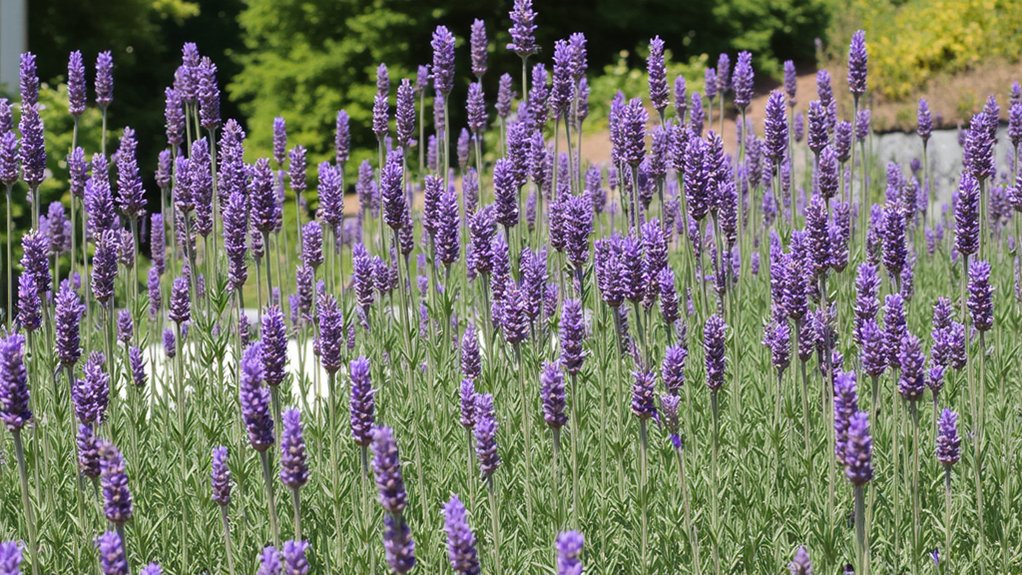
While you might think of lavender as just a pretty, fragrant flower, it’s also a tough, heat-tolerant plant that can thrive in scorching conditions. Don’t underestimate it; this herb loves full sun and can handle temperatures above 90°F with ease.
If you’re planting lavender, choose a spot with at least 6-8 hours of direct sunlight daily. Make sure the soil drains well—mix in gravel or sand if it’s too heavy, aiming for a pH of 6.5 to 7.5. Water sparingly, only every 7-10 days, since overwatering can rot the roots.
Space plants 12-18 inches apart for good air flow, and trim them back by one-third each spring. There ya go—low-maintenance beauty that beats the heat!
Sun-loving Marigolds
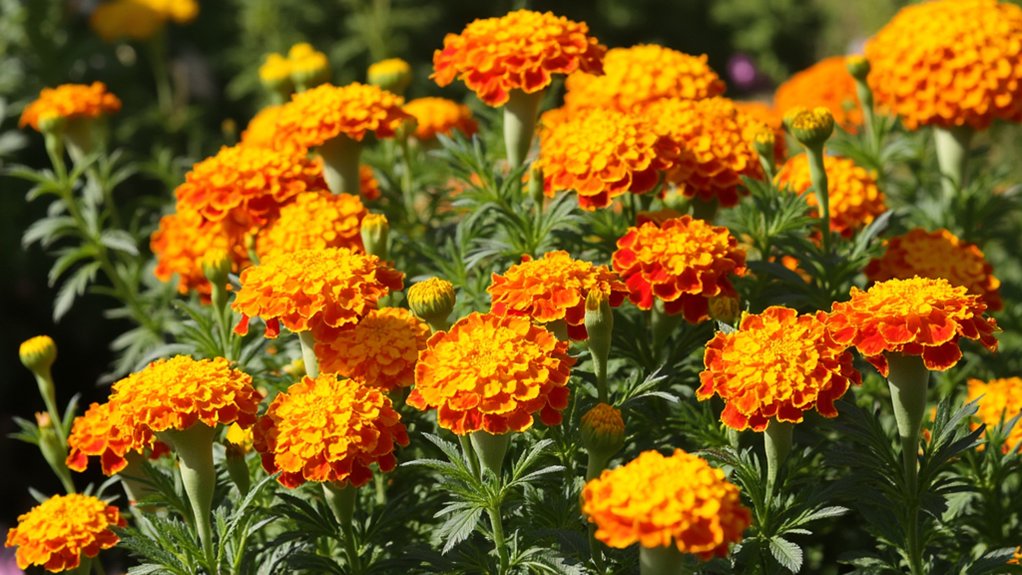
Hey, let’s talk about sun-loving marigolds, a fantastic choice for heat-tolerant gardening. You’ll love how these vibrant flowers thrive in scorching summer sun, adding pops of yellow, orange, and red to your yard. They’re tough, no-nonsense plants that handle drought like champs.
Plant marigolds in well-drained soil, spacing them 8-10 inches apart for good airflow. Make sure they get at least 6 hours of direct sunlight daily, as they won’t bloom well in shade. Water them deeply once a week, about 1 inch, but don’t overdo it—soggy roots spell trouble.
Deadhead spent blooms regularly to keep ‘em flowering from June to frost. With minimal care, you’ve got a garden standout that laughs at heatwaves. Stick with these tips, and you’re set!
Hardy Zinnias
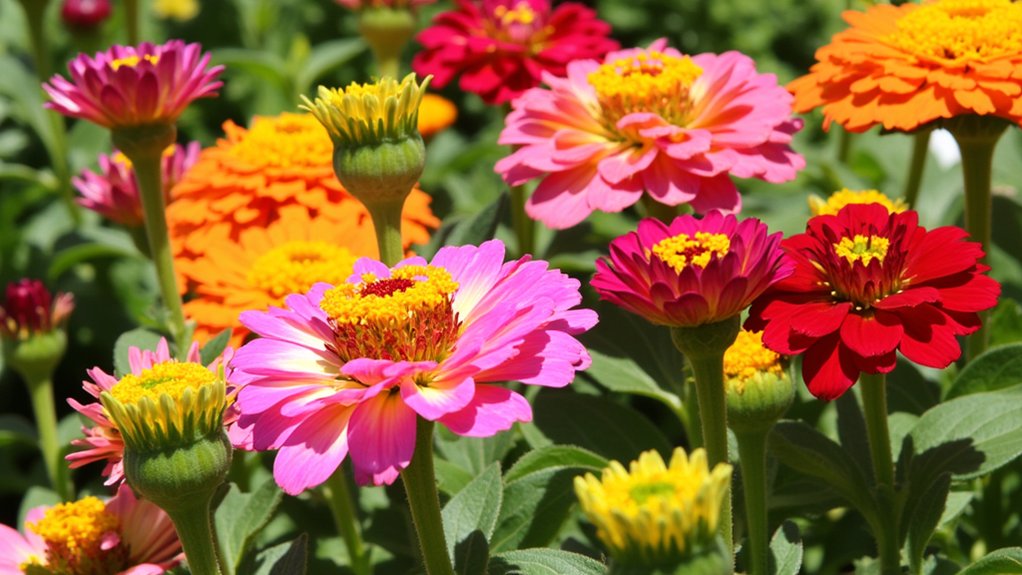
Let’s switch gears and talk about hardy zinnias, another heat-tolerant gem for your garden. You’ll love how these vibrant flowers thrive under scorching sun, no fuss needed. They’re perfect for adding pops of color, even in July’s worst heat.
Start by planting zinnias in well-drained soil, ideally after the last frost, around late spring. Space them 6 to 18 inches apart, depending on the variety, to guarantee good airflow. Water them at the base, about 1 inch weekly, avoiding wet leaves to prevent mildew.
Deadhead spent blooms every few days to encourage more flowers through summer. You can expect blooms in 6 to 8 weeks post-planting, lasting until fall. With minimal care, zinnias’ll keep your garden lively all season long.
Resilient Blanket Flowers

As we move on, check out resilient blanket flowers, a stellar choice for heat-tolerant gardening. You’ll love how these tough beauties, also called Gaillardia, thrive in scorching sun with minimal fuss. They’re perfect for your summer beds or borders.
Plant them in well-drained soil, spacing seedlings about 12-18 inches apart, ideally in spring. Verify they get full sun, at least 6 hours daily, and don’t overwater—let the top inch of soil dry out between sessions. Their vibrant red, yellow, and orange blooms, often 3-5 inches wide, attract pollinators like bees.
Deadhead spent flowers every 2-3 weeks to encourage more blooms through late summer. With minimal care, you’ve got a garden star that laughs at heatwaves. Stick with these, and watch your yard shine!
Durable Sedum Varieties
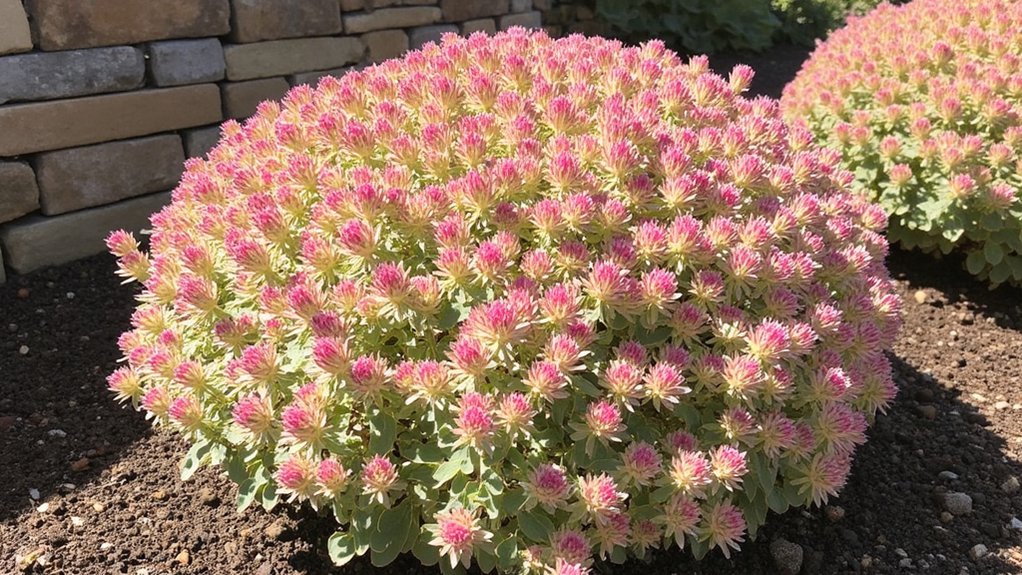
Moving from the vibrant blanket flowers, you’ll find durable sedum varieties just as impressive for heat-tolerant gardens. These tough succulents, often called stonecrop, thrive in scorching sun with minimal care. You can’t go wrong with them if you’ve got poor, rocky soil.
Pick varieties like Sedum ‘Autumn Joy’, which grows to 18-24 inches tall, or Sedum ‘Dragon’s Blood’ for low, 4-6 inch ground cover. Plant them in full sun, spacing about 12 inches apart, and water sparingly—only every 10-14 days during dry spells. Their thick, fleshy leaves store water, so overwatering’s a no-no.
Check for growth in late spring; they’ll bloom by late summer, adding texture. Just trim dead stems in early spring, and you’re set for another hot season.
Tough Russian Sage
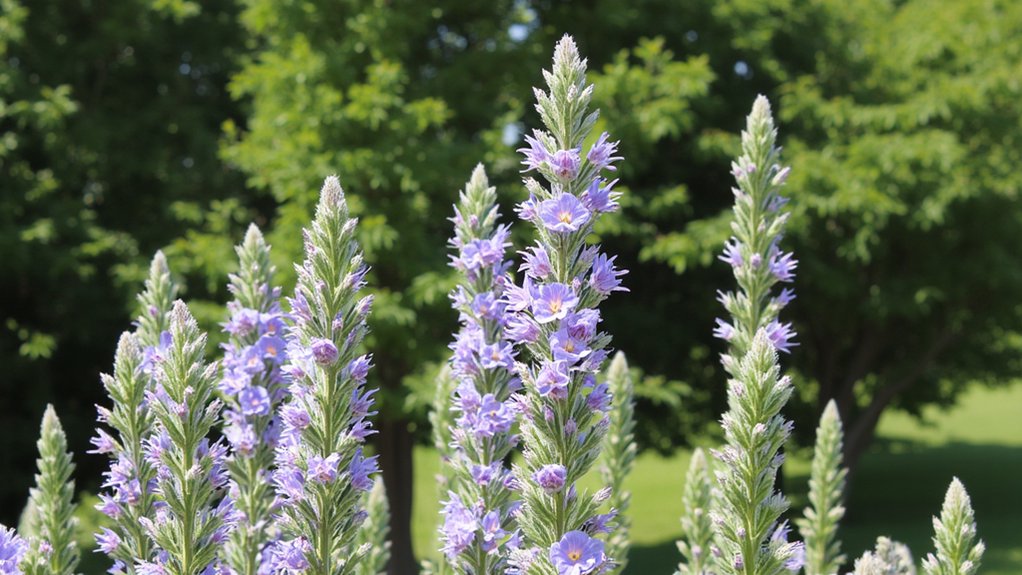
Dive right into the world of tough Russian Sage, a heat-loving perennial that’s a game-changer for your garden. You’ll love how this plant thrives in scorching summers, needing little care. It’s a hardy choice, perfect for dry, sunny spots.
Plant Russian Sage in full sun, ensuring at least 6-8 hours of direct light daily. Space plants about 2-3 feet apart, as they can grow up to 4 feet tall and wide. Water sparingly, only every 2-3 weeks once established, since overwatering can rot the roots.
You’ve gotta admire its silvery-green leaves and lavender-blue flowers blooming from July to October. Trim it back in early spring, cutting to 6 inches, to encourage fresh growth. There ya go, an easy, tough plant!
Vibrant Portulaca Flowers
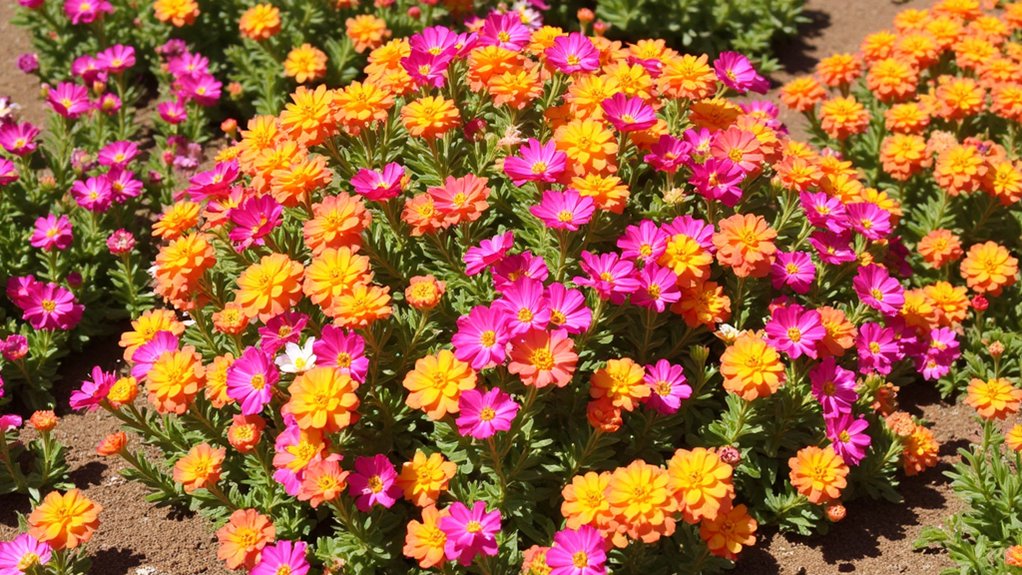
While you’re planning your heat-tolerant garden, let’s talk about Vibrant Portulaca Flowers, a stunning option for sunny spaces. These low-growing beauties, often called moss roses, thrive in scorching heat and poor soil. They’re perfect for borders or containers.
You’ll love how Portulaca blooms in vibrant shades—think hot pink, yellow, and orange. Plant them in full sun, ensuring at least 6 hours of direct light daily, and space seedlings 6-12 inches apart. They grow fast, reaching 3-9 inches tall in just 6-8 weeks. Water sparingly, maybe once a week, since overwatering can rot their roots.
Got rocky or sandy spots? Toss in Portulaca seeds; they’ll sprout without fuss. Just keep weeds at bay, and you’re set for summer color.
Sturdy Coneflowers
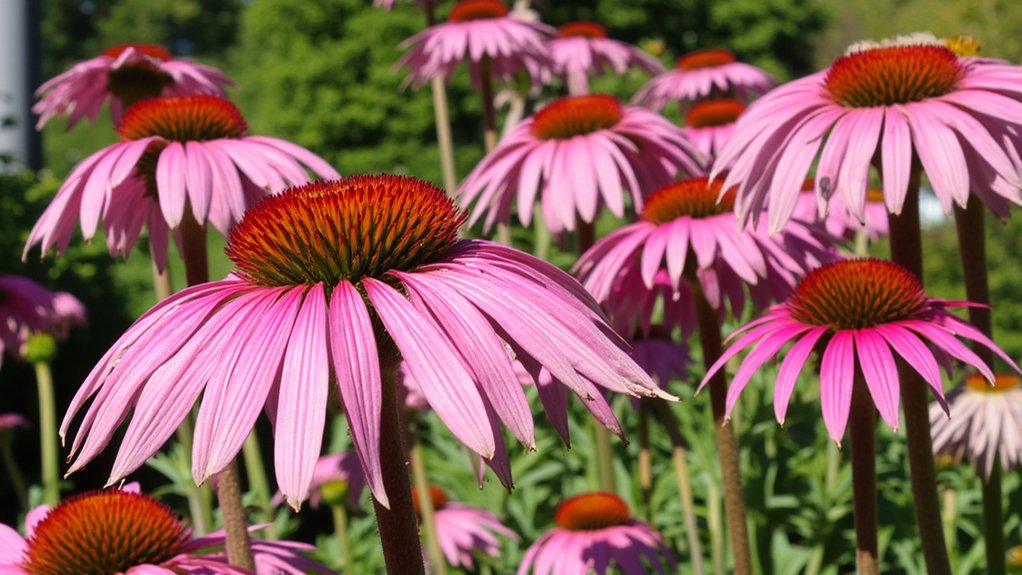
As you build your heat-tolerant garden, let’s focus on Sturdy Coneflowers, a reliable pick for tough conditions. These tough perennials, also known as Echinacea, thrive in scorching summer sun with minimal care. They’ll stand tall, often reaching 2 to 4 feet, even in poor, dry soil.
Wondering how to get started? Plant them in full sun, spacing each one about 18 to 24 inches apart, and water moderately until they’re established, roughly 4 to 6 weeks. After that, they’re drought-resistant, so you won’t need to fuss over them much. Deadhead spent blooms every few weeks to encourage more flowers.
Their sturdy nature means they’ll handle heat waves without wilting. Add these to your beds for lasting, low-maintenance beauty all summer long.
Robust Yarrow Varieties
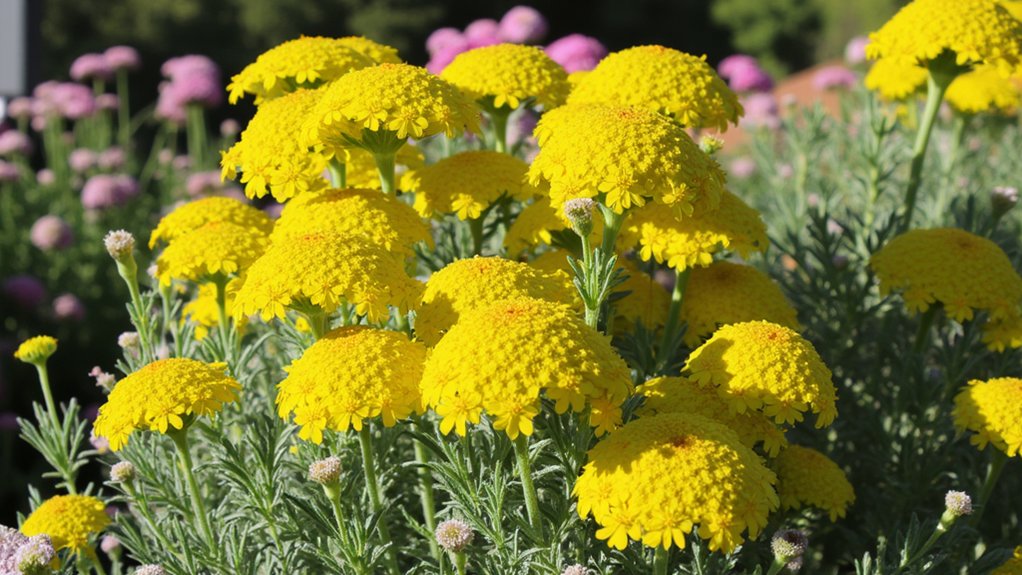
Let’s shift our focus to Robust Yarrow Varieties, another fantastic option for your heat-tolerant garden after exploring Sturdy Coneflowers. You’ll love how these tough plants, like Achillea millefolium, thrive in scorching sun. They’re perfect for dry, sandy soils and need minimal care.
Start by planting yarrow in full sun, ensuring at least 6 hours of direct light daily. Space them 12-18 inches apart, as they spread quickly over 2-3 years. Water sparingly—only about 1 inch per week—since overwatering can rot their roots.
You can expect vibrant blooms, often in yellow or pink, from June to September. Cut back dead stems after flowering to keep them tidy. With these steps, you’re set for a resilient, low-maintenance garden addition.
Hardy Daylilies

Garden enthusiasts, immerse yourself in the world of Hardy Daylilies, a stellar choice for heat-tolerant landscaping. These tough perennials thrive in scorching summers, often blooming vibrantly despite intense sun. You’ll find them easy to grow, needing minimal fuss.
Start by planting them in well-drained soil, ideally in full sun, with 12-18 inches between plants. Water them deeply once a week, about 1 inch total, especially during dry spells. They’re drought-resistant, sure, but don’t skimp on hydration right after planting.
Expect blooms from early summer to fall, with each flower lasting just a day—hence the name! Deadhead spent flowers to keep things tidy and encourage more buds. With over 60,000 cultivars, pick colors and heights, from 1-4 feet, that suit your garden’s vibe.
